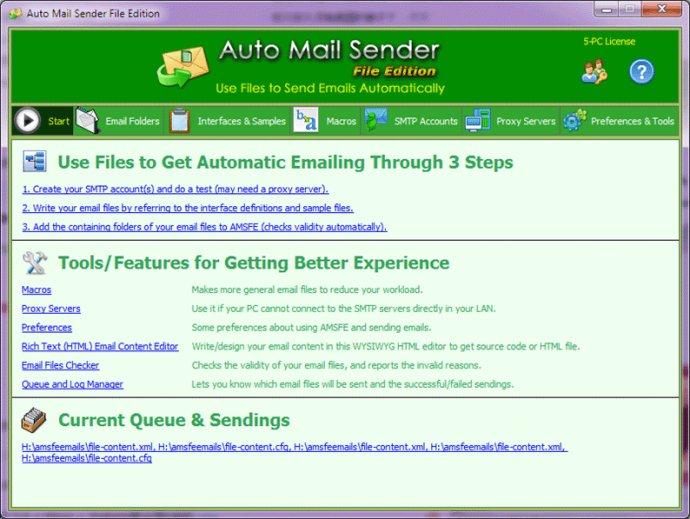Auto Mail Sender File Edition is a flexible and powerful email automation software that lets you send emails automatically at any time and frequency using your files. It also allows you to use your preferred text editor to write emails and create schedules for sending them.

AMSFE offers a range of email interface definitions, sample files, and some basic settings supporting all traditional email elements/functions and uniquely distinctive elements/functions such as sending schedule, sending one by one, repeated sending, automatic resending if failed with maximal times setting, macros manager & built-in macros, folder attachment supportable, emptying folder after sent it successfully, SMTP accounts list, and automatic selection of the available one if the default is not available, deleting email file after sent it successfully, proxy servers list, and automatic selection of the available one if the default is not available, queue and log manager, email files checker and email folder manager, sending a copy to you for each outgoing message, WYSIWYG rich text (HTML) email content editor, custom sender/reply receiver/read receipt receiver, reading recipients/content from external files, SSL/TLS security SMTP connection, creating popular SMTP accounts directly, auto-complete SMTP account settings, and so on.
AMSFE is perfect for personal and professional use, including sending routine business emails, advertisements, work logs, documents, and personal greetings to family members and friends on their special days like birthdays. Additionally, this software can function as a plug-in module to get automatic emailing for your other programs/devices because it provides an email files interface.
In summary, Auto Mail Sender File Edition helps you to alleviate the workload involved in sending emails daily by providing an automated emailing process that is time-efficient, secure and user-friendly.
Version 2.0: supports the embedded images with "file:///..." format that generated by a few operating systems. Now called "Hotmail account" as "Microsoft account", because all Microsoft accounts (such as @outlook.com, @live.com and @hotmail.com) can work under the same SMTP settings. And more.